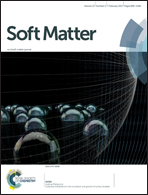Wrinkling of milk skin is mediated by evaporation
Abstract
Wrinkling of thin films and membranes can occur due to various mechanisms such as growth and/or mismatch between the mechanical properties of the film and substrate. However, the physical origins of dynamic wrinkling in soft membranes are still not fully understood. Here we use milk skin as a tractable experimental system to investigate the physics of wrinkle formation in a thin, poroelastic film. Upon heating milk, a micron-thick hydrogel of denatured proteins and fat globules forms at the air–water interface. Over time, we observe an increase in the total length of wrinkles. By confocal imaging and profilometry, we determine that the composition and thickness of the milk skin appears to be homogeneous over the length scale of the wrinkles, excluding differences in milk skin composition as a major contributor to wrinkling. To explain the physical origins of wrinkle growth, we describe theory that considers the milk skin as a thin, poroelastic film where pressure is generated by the evaporative-driven flow of solvent across the film; this imparts in-plane stresses in the milk skin, which cause wrinkling. Viscous effects can explain the time-dependent growth of wrinkles. Our theoretical predictions of the effects of relative humidity on the total length of wrinkles over time are consistent with our experimental results. Our findings provide insight into the physics of the common phenomenon of milk skin wrinkling, and identify hydration gradients as another physical mechanism that can drive morphological instabilities in soft matter.



 Please wait while we load your content...
Please wait while we load your content...